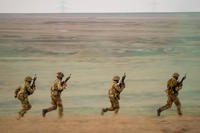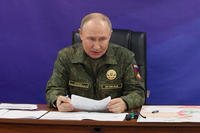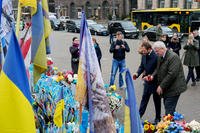Joseph V. Micallef is a best-selling military history and world affairs author, and keynote speaker. Follow him on Twitter @JosephVMicallef.
On Friday, the New York Times published a story claiming that a unit of Russian Military Intelligence (GRU) was paying a bounty to Taliban fighters to target and kill American troops stationed in Afghanistan. NYT claimed that the policy had been approved by Russian President Vladimir Putin, and that at least one American service member had been killed as a result. According to the Times, President Donald Trump was briefed on the practice in March and was subsequently presented with a number of possible policy responses, but has yet to take any action. The story was quickly picked up by the Washington Post and CNN, as well as other media outlets.
Not surprisingly, the news brought a predictable avalanche of criticisms that the Trump administration was soft on Russia and was ignoring the intelligence. Nancy Pelosi, the Speaker of the U.S. House of Representatives and a long-time foe of President Trump, declared: "This is totally outrageous. You would think that the minute the President heard of it, he would want to know more instead of denying that he knew anything."
While shying away from directly criticizing the president, prominent Republicans were quick to weigh in with demands for action. Representative Adam Kinzinger, a five-term Republican Congressman from Illinois' 16th district and an Air Force veteran who served in both Operation Iraqi Freedom and Operation Enduring Freedom, tweeted that Trump, "needs to immediately expose and handle this, and stop Russia's shadow war." Other Republican members of Congress and senators echoed similar comments.
For its part, the Trump administration denied that either the president, Vice President Mike Pence or Chief of Staff Mark Meadows had ever been "briefed on the matter." The denial brought further claims by the NYT that, "One American official had told The Times that the report was briefed to the highest levels of the White House. Another said it was included in the President's Daily Brief, a compendium of foreign policy and national security intelligence compiled for Mr. Trump to read."
Late Sunday night, in a tweet to his supporters, President Trump noted that: "Intel just reported to me that they did not find this info credible, and therefore did not report it to me or @VP."
Subsequent news reports identified the GRU operatives as members of a secret group called Unit 29155. The unit is believed to be tasked with foreign assassinations and other covert activities aimed at destabilizing European countries. Members of the group have been implicated in the assassination of former GRU Colonel Sergei Skripal in March 2018. The unit has also been linked to the Catalan independence movement, a destabilization campaign in Moldova and a failed coup in Montenegro in 2016.
Spokespeople for both the Kremlin and the Taliban have categorically denied the report. Responding to a question from NBC News correspondent Keir Simmons about the existence of the program, according to a report in The Guardian, Dmitry Peskov, Russian President Vladimir Putin's spokesperson replied, "you know, maybe I can say it's a little bit rude but this is 100% bull----."
On Monday evening, the Pentagon issued a statement, declaring, "The Department of Defense continues to evaluate intelligence that Russian GRU operatives were engaged in malign activity against United States and coalition forces in Afghanistan. To date, DOD has no corroborating evidence to validate the recent allegations found in open-source reports."
Sifting through the Evidence
What are we to make of this report? It's entirely possible that the report is accurate; that the GRU paid a bounty to Taliban jihadists for every American service member they killed. Whether the White House was aware of this report is an entirely different matter. It's a serious issue, so it's likely that it would at least have gotten as far as staffers on the National Security Council. Whether the President was ever specifically briefed on the matter is a question that only the White House can answer definitively. So far, they have denied it.
A scrutiny of the evidence, what little there is, however, raises some serious doubts.
First, according to the NYT report, "The crucial information that led the spies and commandos to focus on the bounties included the recovery of a large amount of American cash from a raid on a Taliban outpost that prompted suspicions."
Frankly, that's a nonsensical conclusion. Having spent time in Afghanistan, I can attest from experience that the U.S. dollar is the currency of choice among Afghans. The country has been flooded with dollars since the U.S. intervention in 2001, when CIA operatives famously used million plus dollar cash bribes to flip Afghan warlords against the Taliban and to support the U.S. invasion.
Moreover, the Taliban has evolved a far-ranging web of criminal activities that are believed to bring in upwards of $2 billion dollars a year. Most of that activity, as is true for most international crime, is conducted in U.S. dollars. No self-respecting Afghan warlord, Taliban or other, would be without his stash of American dollars. In Afghanistan that's not the exception, it's the rule.
Moreover, the term "spies and commandos" is awkward. Neither are terms that would be customarily used by the intelligence community, the supposed source of the information.
The NYT article went on to state: "Interrogations of captured militants and criminals played a central role in making the intelligence community confident in its assessment that the Russians had offered and paid bounties in 2019."
What information these interrogations yielded, however, is not disclosed, nor how it supported the contention that the Russians were paying a bounty.
According to the NYT, the bounties were paid to "Islamist militants, or armed criminal elements closely associated with them."
The NYT report added: "Two officials said the information about the bounty hunting was "well known" among the intelligence community in Afghanistan, including the C.I.A.'s chief of station and other top officials there, like the military commandos hunting the Taliban."
According to subsequent reports, the bounties were targeted on both American and NATO troops, especially British troops, as well as Afghan personnel. It's hard to imagine that if this knowledge was so widely dispersed within the intelligence and military community in Afghanistan, it is only now that we are hearing about it. When it comes to Western journalists, Kabul is a pretty small place.
Make no mistake, Russia is actively supporting the Taliban with cash, arms, supplies and intelligence. They have been doing so for several years. These facts are well known to the U.S. intelligence community and the Pentagon and have been extensively documented. For that matter, there is also evidence that Iran has provided assistance to the Taliban, even though they are religiously and ideologically opposed to them and were bitter enemies in the past.
In this sense, Russia is doing to the U.S. exactly what we did to the Soviets when they were bogged down in Afghanistan. Starting with the Carter administration and continuing through the Reagan and Bush administrations, the U.S. supplied financial assistance, arms, supplies, and in some cases, even training, to Afghan militants, including jihadists, fighting the Soviets. U.S. President Ronald Reagan even invited the leaders of the Afghan resistance to a meeting in the Oval Office. In those days, we called them freedom fighters.
The payment of bounties to soldiers or irregular militias for killing enemy combatants is nothing new. It has a long, despicable, history in the annals of warfare. The distinction between paying bounties for killing American military personnel and supporting the Taliban, knowing that support would be used to carry out attacks on American and allied forces, may seem like a subtle difference, but it is an important one.
The U.S. had 17 service members killed in action in Afghanistan in 2019, and another four Americans have been killed so far in 2020 in hostile encounters. In February 2020, the U.S. reached an agreement with the Taliban to end the fighting in return for an eventual pullout of U.S. and allied forces from Afghanistan. The Taliban has refrained from attacking U.S. military personnel since then.
It stands to reason that those Taliban commanders who were particularly successful in attacking U.S. troops would receive more assistance from Russia. We used similar criteria when we were supporting the anti-Soviet resistance in Afghanistan. You can certainly make the argument that the more Americans the Taliban killed, the more cash and arms they received from the Kremlin. Whether this constitutes a de facto bounty is open to debate.
The larger question we should pose, however, is who benefits from the release of this information? The obvious answer is Russia. The Kremlin doesn't want the U.S. to disengage from Afghanistan. They're perfectly happy to see the U.S.-Taliban agreement fall apart and for the U.S. to continue to be bogged down there. In the short term, Moscow is content to cause problems for the U.S. even if that means supporting an organization that, long-term, is inimical to Russian interests in the region.
In fact, this whole incident feels like a classic example of a Soviet style misinformation campaign. It has just enough truth in it to be credible but packaged, i.e., spun, in such a way as to cause maximum disruption in the U.S.
Disclosing that Russia is aiding the Taliban is old news that has been ignored for several years. Repackaging that news as "Russia is paying bounties to Taliban militants to kill American servicemen." given how politicized U.S. foreign and defense policy has become, is like a grenade, or in this case a Molotov Cocktail, thrown into the fabric of American politics. The consequences are predictable.
Moscow may well be paying bounties to Taliban militants to kill Americans and doing so with the full knowledge and consent of Vladimir Putin. Then again, this may simply be a case of the old news of Russian aid repackaged and spun to advance Russian interests.
Even if the Taliban has elected not to take such bounties, that doesn't mean that the Kremlin cannot find other elements, both criminal and other, in Afghanistan to whom it can offer support or even bounties in order to torpedo the U.S.-Taliban agreement. As usual the shadow war between Washington and Moscow is always more nuanced and complex than what meets the eye. What's unfortunate is how readily the U.S. media allows itself to be manipulated by the Kremlin.
-- The opinions expressed in this op-ed are those of the author and do not necessarily reflect the views of Military.com. If you would like to submit your own commentary, please send your article to opinions@military.com for consideration.















